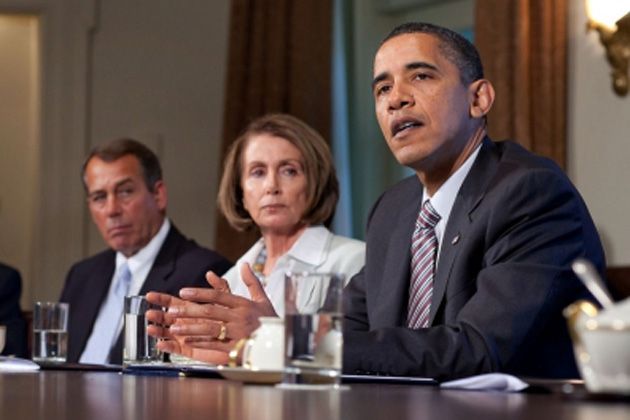(Source: Pete Souza)
Before the Shutdown, there was the Sequester: deep spending cuts for nearly every branch and department of the government, accompanied by a lapse in an equally broad array of tax subsidies. With all of the events and political-economic catastrophes of the past year, an important detail being crowded off the cliff of our collective memory is that sequestration was never actually supposed to happen. Can understanding why it did help us head off another shutdown at the next round of debates in February?
Sequestration was cooked up during the last major economic standoff, as a device to force both parties to compromise. It was designed to contain “worst-case” outcomes for both sides, a supposedly foolproof incentive to remain at the bargaining table.
| Game theory is garnering increasing interest as a tool for making sense of the seemingly bizarre behaviors of our representatives in Washington. It can also provide some understanding of what went wrong with the sequester. And, perhaps, how to fix it. |
For the Democrats, the consequences were across-the-board spending cuts to nearly all social services, and the foregoing hundreds of billions of otherwise-promised tax revenue. For Republicans, a guaranteed end to the Bush-era tax subsidies for high earners and cuts to military spending—long a sacred cow, especially during wartime.
These consequences were supposed to be too grave to allow to pass. And yet, they did.
Over the first nine months it has been in effect, since March of this year, has already brought $85 billion of real spending cuts, compared to last year.
While the effects are widely felt—from fundamental military training to biomedical research, even New York City’s annual “fleet week,” programs that once seemed points of unassailable consensus—it’s not yet known whether any resolution to the shutdown will restore funding to pre-sequestration levels.
How did this happen?
Last week, pioneering behavioral game theorist—and newly-minted MacArthur ‘genius’ fellow—Colin Camerer compared the shutdown to a game of chicken, with both sides trying not to be the first to careen away from their crash course. He used the analogy to suggest that the president had the upper hand in this game, because as an individual actor he can in theory progress with a more consistent strategy—which is, mathematically speaking, an advantage in most variants of the game.
Game theory is garnering increasing interest as a tool for making sense of the seemingly bizarre behaviors of our representatives in Washington. It can also provide some understanding of what went wrong with the sequester. This standoff, which resulted in previously-unthinkable consequences for everyone involved, evokes another dangerous confrontation between hostile parties in which game theory played a role: the Cold War.
By the 1960s, the Soviet Union and the U.S. were capable of launching enough nuclear warheads to destroy the world. Both governments employed game theorists to navigate the strategic complexity of these devastating arsenals. What they proposed was as counterintuitive as it was coldly rational: The credibility of threat—and the totality of devastation—was key to maintaining the peace. The steady state that resulted from the specter of looming annihilation was termed Mutual Assured Destruction (MAD).
Remaining in this balance required both sides to believe that the other was simultaneously interested in preserving their own populace and also willing to counterattack if that populace were threatened. As long as those conditions remained satisfied, then neither country could independently act to better their position—in technical terms, they were each locked in to “equilibrium” strategies from which they should not “deviate”. Sixty years on, we have experienced no aggressive detonations of a nuclear weapon.
And that’s basically how the sequester was supposed to work.
Neither side would risk destroying the programs and ideals that their constituents considered essential, so the players were supposed to stop firing at each other and attempt to coexist in a steady, productive—if not necessarily harmonious—détente. But it seems that the mathematical safety net promised by “Mutual Assured Destruction” may have been tested by economic ideologies in ways that it (thankfully) never was by nuclear aggression.
What Congress and the president may have stumbled into is a little-discussed, but long-known, fact about Mutual Assured Destruction. Namely, the strategy’s rationality slips when a third player is added to the game who has a different set of incentives than the others.
If this third player has little value for comparable holdings—no interest in preserving a populace, for instance—then that player is not bound by the equilibrium of the other two—and, in fact, makes such an equilibrium impossible. Indeed, the mere accumulation of weapons of destruction can increase the chance that one will slip into this dangerous player’s hand.
In other words, once the Tea Party entered the room, the less-reactionary forces in Congress and the president should have collaborated to put the knives away. The existence of players who are known to have wildly asymmetric payoffs meant that, in a budget process that offers ample room for catastrophic deadlock, measures like the sequester (and, consequently, the shutdown) would, inevitably, come to pass. Hours before the shutdown officially ended, Tea Party reps asserted that they are ready to“start this all over again,”for “round two.”
So where do we go from here?
One idea is to simply eliminate the third player, the one with the destructive payoff function. Despite the desire on both sides of the aisle to rid the Republican Party of its Tea Party caucus, this is unfortunately electorally infeasible for at least the near-term, for reasons of political geography, as well as sheer inertia. More importantly, however, it’s an example of the sort of limited thinking that helped get us into this problem in the first place: namely, a focus on political horseraces over the opportunity for real, structural change. This type of approach is always fighting the last war, rather than preventing the next one.
Here’s an example of a forward-thinking change: The rules of the legislature are designed to contain the impact of an obstructionist minority, but remain fragile to the whims of an intentionally destructive extremist coalition that has control over the majority. How might the system be designed to resist such catastrophic outcomes, while still preserving the constitutional authority of Congress? One approach is to turn again to behavioral economics, and look at ways to re-frame the choices available to Congress.
One such change would be to include in each budget a provision for automatic renewal at current (or inflation-adjusted) levels if no budget were passed the next year. We should expect that this provision would never be triggered, given the incredible incentives to modify appropriations each year. But, in the case of an impasse like the one we’ve just experienced (and will likely come to again, in February), the failsafe option would be far less catastrophic than government shutdown. The renewal could of course be undone by further acts of Congress, but the crucial point is that in order to shut down the government, Congress would have to take active steps, rather than simply letting the budget expire.
There would be all sorts of downsides to this eventuality, but none nearly so bad as a total government shutdown. The sequester—and the shutdown—came about because neither side would act to prevent disaster. But if the mechanics were shifted, then the onus would be on the players to act—to take responsibility for launching the first strike.
The problem is that it would take a proactive step to initiate measures like auto-renewing budgets —and that step would have to be taken by many of the same actors who are complicit in this most recent detonation. Luckily, it appears that we’re nearing a unique political moment—the electorate is roundly appalled by the shutdown, and eager to assign blame. Those who want to seize this opportunity for meaningful change should channel that anger—not let it dissipate with the inevitable distaste at the next round of political jockeying.
If policymakers act now to change the frame, for themselves and their successors, they can help avert the next round of MAD-ness, before it starts.
Aaron Bornstein is an independent writer living in New York City.







0 Comments